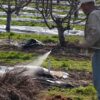
During a keynote presentation at this year’s Cultivate, Ken Fisher, AmericanHort’s President and Chief Executive Officer reviewed the 2019 State of the Horticulture Industry. Ken reported the state of the industry to be good. He specifically mentioned three positive factors impacting the industry: strong consumer spending, a steady housing industry, and strong consumer sales. Despite these three positive trends, Ken also mentions three lingering concerns he felt the industry needed to address: labor supply, industry margins, and the development of the next generation of gardeners. As I listened to the presentation, I thought to myself about how the product I sell, MycoApply mycorrhizae, addressed these three concerns.
Before we jump into the three concerns, I think it might be best to give a quick overview of the role mycorrhizae can play in a plant’s life. Mycorrhizae are a naturally occurring soil fungal organism that forms a symbiotic relationship with close to 95 percent of all plants. The plant supplies sugars and lipids to feed the mycorrhizae and in return the mycorrhizae expand the plant’s root mass by the development of an expansive fungal hyphae network. This network is more effective and efficient at the uptake of water and nutrients than the roots could possibly be alone. The resulting increased supply of nutrients and water reduces the stress experienced by the plant and allows the plant to focus on its purpose: flowers, yield , etc.
Labor
Labor costs can be reduced both directly and indirectly by the use of mycorrhizae. This reduction can happen in a variety of ways. It can happen from the reduction in fertilizer and pesticide applications due mycorrhizae improving nutrient uptake and overall plant vitality. Watering can be reduced, resulting in less labor hours per plant, as the plants more efficiently uptake water and store it during times of excess for use during times of need. Growers can also experience more uniform plant growth resulting in a more uniform production, which in turn results in less labor costs.
Industry Margins
Margins increase in a variety of ways when growers choose to grow with mycorrhizae. In addition to reduced labor costs as previously stated, the reduction of fertilizer and pesticides will also increase margins. When growers use less water, a common benefit of mycorrhizae usage, they reduce pumping costs and other costs of water usage, both resulting in increased margins. Reduced water and nutrient run-off can also reduce environmental remediation costs. Plants grown with mycorrhizae have less transplant shock and this reduces plant loss during transplant. A more uniform crop from the use of mycorrhizae has the potential to shorten crop time and offer more “bench-run” harvesting. Both of these features directly tie to increasing margins.
The use of mycorrhizae enhances a plant’s ability to handle stress during shipment to a retail customer. Plants simply come off the truck looking better and more appealing to the public. If the plants are not immediately sold due to weather or other market complicators, plants grown with mycorrhizae have an improved shelf-life. This trait reduces plant maintenance costs and additionally reduces plant losses and returns at retail.
Next Generation Gardeners
How does our industry inspire the next generation of gardeners? Gardening has to attract new gardeners by offering some type of value or pleasure. What keeps new gardeners coming back is the joy they experience in having their home flowerbed or vegetable garden look more attractive, and from the total satisfaction of picking and eating their first vine ripened tomato.
You might ask yourself, how can mycorrhizae help new gardeners? Most gardeners purchase plants at a garden center rather than starting their own plants from seed. For these new plants to succeed they need to be transplanted into a container/basket or into a flower or vegetable garden. The key word here is transplant. Transplant shock is a major reason why many new gardeners fail. Mycorrhizae work to reduce transplant shock, and allow for greater plant survival, quicker transformation back to the plant growing and flowering and ultimately greater garden performance.
Mycorrhizae help new gardeners and, really all gardeners, in a very basic way. They help plants to get more nutrients to grow and more water to survive. Once a plant leaves a greenhouse or nursery, their life will never be the same. Consistent watering and fertilization will become a thing of the past. Both will happen when the home gardener remembers to do these activities. From our trials, we have found mycorrhizae-treated containerized plants survive 36-48 hours longer than untreated plants with the same amount of water. In the fungal hyphae, mycorrhizae store excess water and release it to the plant when it is needed. What does that mean? Maybe hanging baskets surviving a weekend when the home gardener goes out of town. It also means that when the home gardener comes home and they see the wilted plant, that the plant once watered will more quickly bounce back to peak performance.
Home garden plant fertilization is usually even less frequent than watering. Some gardeners use a controlled release fertilizer in their potting soil or that is added at time of planting. Others apply a liquid fertilizer throughout the growing season. Mycorrhizae help plants to capture more of these fertilizer nutrients as they are applied or released. When there is an excess of fertilizer, the mycorrhizae store the nutrients and then release them to the plant when they are needed by the plant. What does this mean? A greater percent of the nutrients available to the plant are consumed by the plant leading to darker green leaves and less nutrient deficiency issues. In short, better looking and higher performing plants.
Mycorrhizae are not the only answer to the three challenges discussed in the Cultivate’19 keynote, but they are part of the answer as our industry works to address these concerns. In part, mycorrhizae will also play a role in helping to change the state of the horticulture industry from good to great!
For more information about MycoApply Mycorrhizae, please explore our website: https://mycorrhizae.com
If you have any questions about anything covered in this article, please contact us at 866-476-7800 or email us at inquiries@mycorrhizae.com.
Article by: Blair Busenbark
Mycorrhizal Applications – Sales & Commercial Marketing Manager
November 12, 2019






